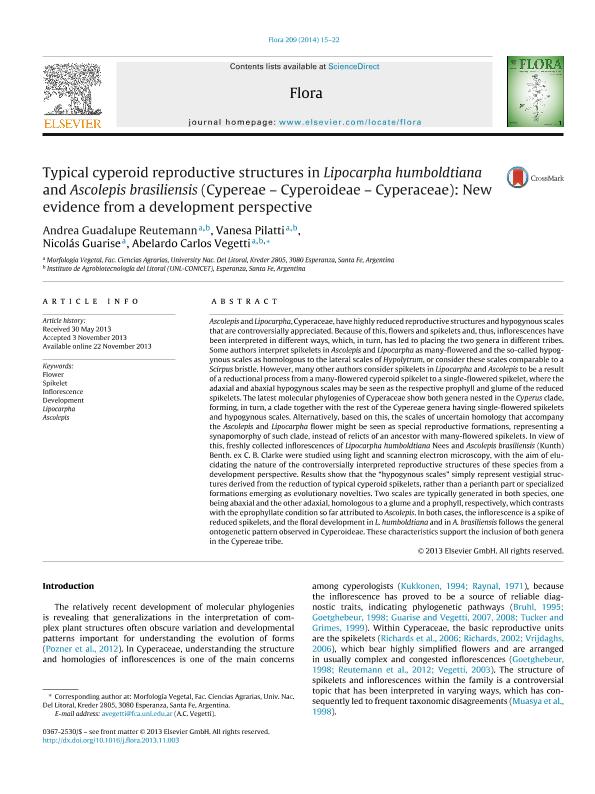Mostrar el registro sencillo del ítem
dc.contributor.author
Reutemann Arnolfo, Andrea Guadalupe

dc.contributor.author
Pilatti, Vanesa

dc.contributor.author
Guarise, Nicolas Javier

dc.contributor.author
Vegetti, Abelardo Carlos

dc.date.available
2016-12-16T19:45:41Z
dc.date.issued
2014
dc.identifier.citation
Reutemann Arnolfo, Andrea Guadalupe; Pilatti, Vanesa; Guarise, Nicolas Javier; Vegetti, Abelardo Carlos; Typical cyperoid reproductive structures in Lipocarpha humboldtiana and Ascolepis brasiliensis (Cypereae-Cyperoideae-Cyperaceae): new evidence from a development perspective; Elsevier; Flora; 209; 1; -1-2014; 15-22
dc.identifier.issn
0367-2530
dc.identifier.uri
http://hdl.handle.net/11336/9608
dc.description.abstract
Ascolepis and Lipocarpha, Cyperaceae, have highly reduced reproductive structures and hypogynous scales that are controversially appreciated. Because of this, flowers and spikelets and, thus, inflorescences have been interpreted in different ways, which, in turn, has led to placing the two genera in different tribes. Some authors interpret spikelets in Ascolepis and Lipocarpha as many-flowered and the so-called hypogynous scales as homologous to the lateral scales of Hypolytrum, or consider these scales comparable to a Scirpus bristle. However, many other authors consider spikelets in Lipocarpha and Ascolepis to be a result of a reductional process from a many-flowered cyperoid spikelet to a single-flowered spikelet, where the adaxial and abaxial hypogynous scales may be seen as the respective prophyll and glume of the reduced spikelets. The latest molecular phylogenies of Cyperaceae show both genera nested in the Cyperus clade, forming, in turn, a clade together with the rest of the Cypereae genera having single-flowered spikelets and hypogynous scales. Alternatively, based on this, the scales of uncertain homology that accompany the Ascolepis and Lipocarpha flower might be seen as special reproductive formations, representing a synapomorphy of such clade, instead of relicts of an ancestor with many-flowered spikelets. In view of this, freshly collected inflorescences of Lipocarpha humboldtiana Nees and Ascolepis brasiliensis (Kunth)Benth. ex C. B. Clarke were studied using light and scanning electron microscopy, with the aim of elucidating the nature of the controversially interpreted reproductive structures of these species from a development perspective. Results show that the ?hypogynous scales? simply represent vestigial structures derived from the reduction of typical cyperoid spikelets, rather than a perianth part or specialized formations emerging as evolutionary novelties. Two scales are typically generated in both species, one being abaxial and the other adaxial, homologous to a glume and a prophyll, respectively, which contrasts with the eprophyllate condition so far attributed to Ascolepis. In both cases, the inflorescence is a spike of reduced spikelets, and the floral development in L. humboldtiana and in A. brasiliensis follows the general ontogenetic pattern observed in Cyperoideae. These characteristics support the inclusion of both genera in the Cypereae tribe.
dc.format
application/pdf
dc.language.iso
eng
dc.publisher
Elsevier

dc.rights
info:eu-repo/semantics/openAccess
dc.rights.uri
https://creativecommons.org/licenses/by-nc-nd/2.5/ar/
dc.subject
Flower
dc.subject
Spikelet
dc.subject
Inflorescence
dc.subject
Development
dc.subject
Lipocarpha
dc.subject
Ascolepis
dc.subject
Cypereae
dc.subject
Cyperoideae
dc.subject.classification
Ciencias de las Plantas, Botánica

dc.subject.classification
Ciencias Biológicas

dc.subject.classification
CIENCIAS NATURALES Y EXACTAS

dc.title
Typical cyperoid reproductive structures in Lipocarpha humboldtiana and Ascolepis brasiliensis (Cypereae-Cyperoideae-Cyperaceae): new evidence from a development perspective
dc.type
info:eu-repo/semantics/article
dc.type
info:ar-repo/semantics/artículo
dc.type
info:eu-repo/semantics/publishedVersion
dc.date.updated
2016-11-23T20:14:28Z
dc.journal.volume
209
dc.journal.number
1
dc.journal.pagination
15-22
dc.journal.pais
Alemania

dc.journal.ciudad
Berlin
dc.description.fil
Fil: Reutemann Arnolfo, Andrea Guadalupe. Universidad Nacional del Litoral. Facultad de Ciencias Agrarias. Catedra de Morfologia Vegetal; Argentina. Consejo Nacional de Investigaciones Científicas y Técnicas. Centro Científico Tecnológico Santa Fe. Instituto de Agrobiotecnologia del Litoral; Argentina
dc.description.fil
Fil: Pilatti, Vanesa. Universidad Nacional del Litoral. Facultad de Ciencias Agrarias. Catedra de Morfologia Vegetal; Argentina. Consejo Nacional de Investigaciones Científicas y Técnicas. Centro Científico Tecnológico Santa Fe. Instituto de Agrobiotecnologia del Litoral; Argentina
dc.description.fil
Fil: Guarise, Nicolas Javier. Universidad Nacional del Litoral. Facultad de Ciencias Agrarias. Catedra de Morfologia Vegetal; Argentina
dc.description.fil
Fil: Vegetti, Abelardo Carlos. Consejo Nacional de Investigaciones Científicas y Técnicas. Centro Científico Tecnológico Santa Fe. Instituto de Agrobiotecnologia del Litoral; Argentina. Universidad Nacional del Litoral. Facultad de Ciencias Agrarias. Catedra de Morfologia Vegetal; Argentina
dc.journal.title
Flora

dc.relation.alternativeid
info:eu-repo/semantics/altIdentifier/url/http://www.sciencedirect.com/science/article/pii/S0367253013001266
dc.relation.alternativeid
info:eu-repo/semantics/altIdentifier/doi/http://dx.doi.org/10.1016/j.flora.2013.11.003
Archivos asociados
